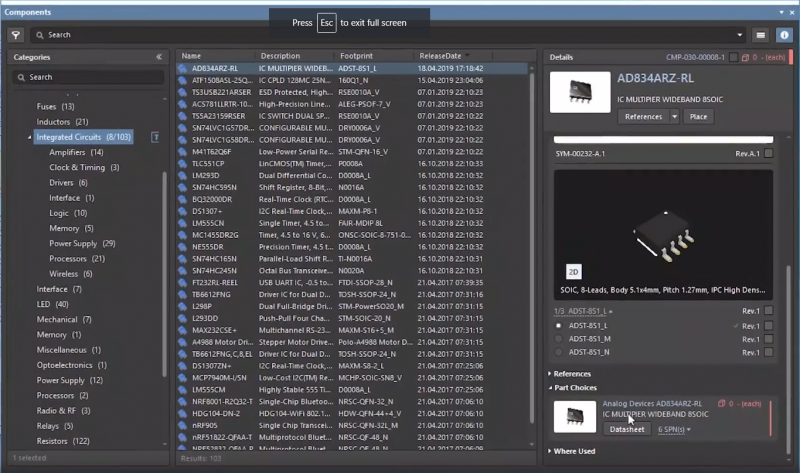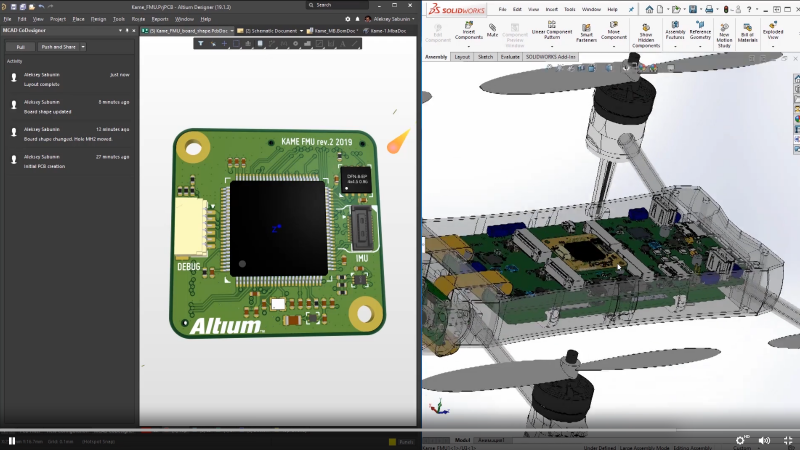PCB Design Reuse and Product Lifecycle Management in Altium Concord Pro
Reusing design data is a great way to hasten redesigns of existing hardware. Managing this design data, including version control and component data management, can be a real challenge. Production lead times are decreasing, component lifecycles are shorter, replacement parts are pushed to market sooner, and design data steadily grows as new designs become more complex.
Reusing design data for a portion of an existing board or functional blocks within a device is a great way to hasten the board design process. With the importance of managing design data and hastening design updates, product engineers need tools that allow component lifecycle management and codesign within a single application.
Integrating these capabilities in a single software interface allows new product designs to move to production faster while preventing the need for redesigns. This also gives you live supply chain information directly from component distributors, and this data can be passed directly into your bill of materials for your manufacturer. Altium Concord Pro is the only component and data management platform that offers this level of visibility and integrates with mechanical design platforms. You’ll have the component visibility you need to avoid redesigns, production delays, and properly reuse design data in new devices.
ALTIUM CONCORD PRO®
A unified data and product lifecycle management platform that integrates with Altium Designer® and other mechanical design tools.
All components in electronic devices, and even devices themselves, have finite lifecycles. At some point, an piece of hardware can no longer keep up with new applications and must be retired in favor of a newer version. Hardware design teams and product development engineers must keep this in mind when designing electronics for existing applications, and should try to extend the application lifetime of their product by anticipating new applications.
At some point, individual components become obsolete and are replaced with newer, more powerful versions. Keeping up with new component releases can be challenging when this information is not compiled in a single location. No one should have to scour component distributor websites just to keep up with this critical aspect of sourcing. What if there were tools that gave you real-time supply chain visibility directly alongside your design tools and allowed you to instantly incorporate this data into your bill of materials?
With the right supply chain visibility and data management capabilities, you can anticipate changes in the supply chain and extend the lifecycle for your new hardware. With Altium Concord Pro, you’ll have access to instant supply chain information alongside your important PCB design tools. Your design software can now help you keep track of sourcing data once it becomes available and suggest suitable replacements based on operating parameters, footprints, cost, and more.
Product lifecycle management doesn’t have to be an abstract business term anymore. Design teams can now truly manage all aspects of the product lifecycle with Altium Concord Pro.
Challenges in PCB Design Reuse and Product Lifecycle Management
Common challenges in PCB design reuse and product lifecycle management arise due to a lack of sourcing information, lack of access to component model updates, and an unclear data management process. This means that product lifecycle management is really a data management problem. Hardware designers and engineers need key information on their supply chain and component sources in order to anticipate changes in the supply chain and assess the potential benefits of redesigning a product. New applications emerge over time, and design teams need to be ready to meet these new demands and challenges as technology continues to advance.
The challenges involved in lifecycle management can be overcome with the right data management and PLM solution. When you have live information on component obsolescence and timelines for new releases, you can incorporate these into your upgraded PCBs during redesigns. You’ll no longer have to react to product updates; instead, you can plan your redesigns before obsolescence and get a head start on your competition with the right PLM solution.
How a Product Lifecycle Management Platform Aids Redesigns
Common problems in product lifecycle management for PCBs can be overcome when your design, data management, documentation, and manufacturing planning features can access your design and component data within a single program. There are some real benefits of connecting PCB design reuse to PLM directly in your design software. The best software for PCB lifecycle management places imports component information updates directly into your design software and allows you to quickly use these updates to redesign your board.
Once you begin a redesign, you’ll often need to place new components in your design in order to expand the capabilities of your device. When you have access to live sourcing and component data in your design software, you can immediately import updated components into your redesigns. You won’t have to scan through your schematics and manually replace components.
- Product lifecycle management for printed circuit boards takes the right data management and supply chain visibility tools. With the right PLM solution, you can anticipate redesigns and the end of the product lifecycle instead of reacting.
Learn more about the product lifecycle for printed circuit boards.
- You can synchronize your design and data management processes when your design data passes easily between schematic, layout, and component management tools.
- Supply chain visibility tools that integrate into your library management features help expedite redesigns by instantly grabbing component data updates.

Sourcing and footprint information in Altium Concord Pro
How to Improve PCB Design Reuse and PLM
A redesign may often be required when a component you planned to use in a new design suddenly becomes obsolete. The lifecycle for existing products often ends when components in those products become obsolete, and new applications require newer components. When working on PCB redesigns or new versions of existing products, you’ll need to swap out components in your board with their updated versions.
A mechanical model for your board needs to be synchronized with your electrical model so that your mechanical packaging can be designed accurately. Working with a unified design package allows your MCAD and ECAD tools to grab data from the same library of data. When your libraries also have access to real-time supply chain information, you can anticipate the end of a product’s lifecycle and plan for redesigns early.
ECAD/MCAD Collaboration and Design Reuse
A platform that offers full unification of your computer-aided design tools with data management and sourcing tools doesn’t have to stop with product lifecycle management. Your data management platform should also allow you to make changes to your mechanical layout and packaging. Connectors and component models are periodically updated by manufacturers, and new design versions should include these new models in order to keep up with changes in the supply chain.
The right data management and supply chain visibility tools will allow you to quickly import updates into your mechanical tools without exporting data between programs. This greatly improves your workflow and productivity while enforcing harmony between design tools. When electrical and mechanical models for your circuit boards product lifecycle requires can pass between your ECAD and MCAD programs, you can manage all aspects of the product lifecycle and quickly reuse existing data in new designs. Integrating these features alongside data management features allows you to quickly pass component updates to your new designs.
- Unified design software makes lifecycle management for electronic products much easier.
Learn more about the electronic product lifecycle management process.
- Reliable library and component management tools with real-time supply chain information can help expedite design reuse.
Learn more about working with sourcing information in your design software.
- Data management for design reuse requires grabbing component model updates for ECAD and MCAD design. This aids the overall product lifecycle management process.
Learn more about managing mechanical models as part of lifecycle management.

Synchronizing electronic and mechanical design with Altium Concord Pro
Design Reuse and Data Management in a Unified Environment
Successful product development goes far beyond using CAD tools for circuit board layout. Each PCB design tool in your design software should have access to the same set of layout and component data without having to send everything to an external program. Working in a design platform that runs on a unified rules-driven design engine ensures that your design data can easily pass between your PCB design tools.
Circuit board redesign and reuse is much easier when your component data quickly passes between your PCB component libraries, schematics, and layout. This expedites updates to existing PCB and allows you to reuse portions of your design in new projects. This type of design software also allows you to work with hierarchical schematics, allowing you to easily reuse circuit blocks and quickly link them together throughout complicated layouts.
PCB design tools and software that run on a single rules-driven design engine make it easy to modify design rules so that your new product complies with specific industry standards. You can then send your fully compliant electrical designs to your MCAD tools for packaging design. Only Altium Concord Pro works within Altium Designer to streamline PCB design reuse and product lifecycle management.
Altium Concord Pro: Unifying Redesigns and Product Lifecycle Management
A collaborative ECAD/MCAD system that interfaces with component data updates and supply chain information makes it easy to redesign your board and organize multiple hardware versions. Other MCAD programs have little to no data management capabilities, and none of the design or data management tools will synchronize with a powerful ECAD program. Combining Altium Designer with Altium Concord Pro offers the best data management and design reuse platform for PCBs and overall product lifecycle management.
If you are creating packaging in an external program like SolidWorks or Autodesk Inventor, Altium Concord Pro will easily grab updates to your component models in Altium Designer and synchronize them in your MCAD software. You’ll be able to design the most accurate mechanical packaging quickly and easily when your design tools work together. Altium Concord Pro integrates with these other MCAD tools as a standard plugin and is built into Altium Designer.
- Altium Designer’s unified environment integrates important design and product lifecycle management tools in a single platform. The underlying rules-driven design engine provides synchronization between management, design, and verification tools.
Learn more about the unified design environment in Altium Designer.
- Altium Concord Pro seamlessly synchronizes the native 3D design tools in Altium Designer with component and supply chain management tools, and your component data will be imported directly into your MCAD program for packaging design.
Learn more about real-time bill of materials and sourcing updates in Altium Designer.
- Don’t get stuck trying to build your board twice with different ECAD and MCAD tools. You can easily pass board updates between programs when you use Altium Concord Pro.
Other MCAD tools have little to no support for data management, and they don’t allow you to create sleek, professional packaging for new hardware right alongside your PCB. Instead of forcing you to export data between programs, Altium takes integration to the next level with Altium Concord Pro, the only data management solution that synchronizes all aspects of supply chain management, ECAD, and MCAD design.
Altium gives you the resources you need to design and manage your product data for any and all applications. You’ll have access to the AltiumLive forum, webinars and podcasts with industry experts, design tutorials, and an extensive knowledge base with plenty of design tips. No other PCB design software company give you this level of support.
Altium Designer continues to set the standard in PCB design, and Altium Concord Pro is the perfect complement to this design platform. By integrating your ECAD, MCAD, and data management features into a single platform, you can easily pass design data updates between these important design features and control all aspects of your product in a single platform. Anyone that uses Altium Designer can watch their productivity skyrocket with Altium Concord Pro.
